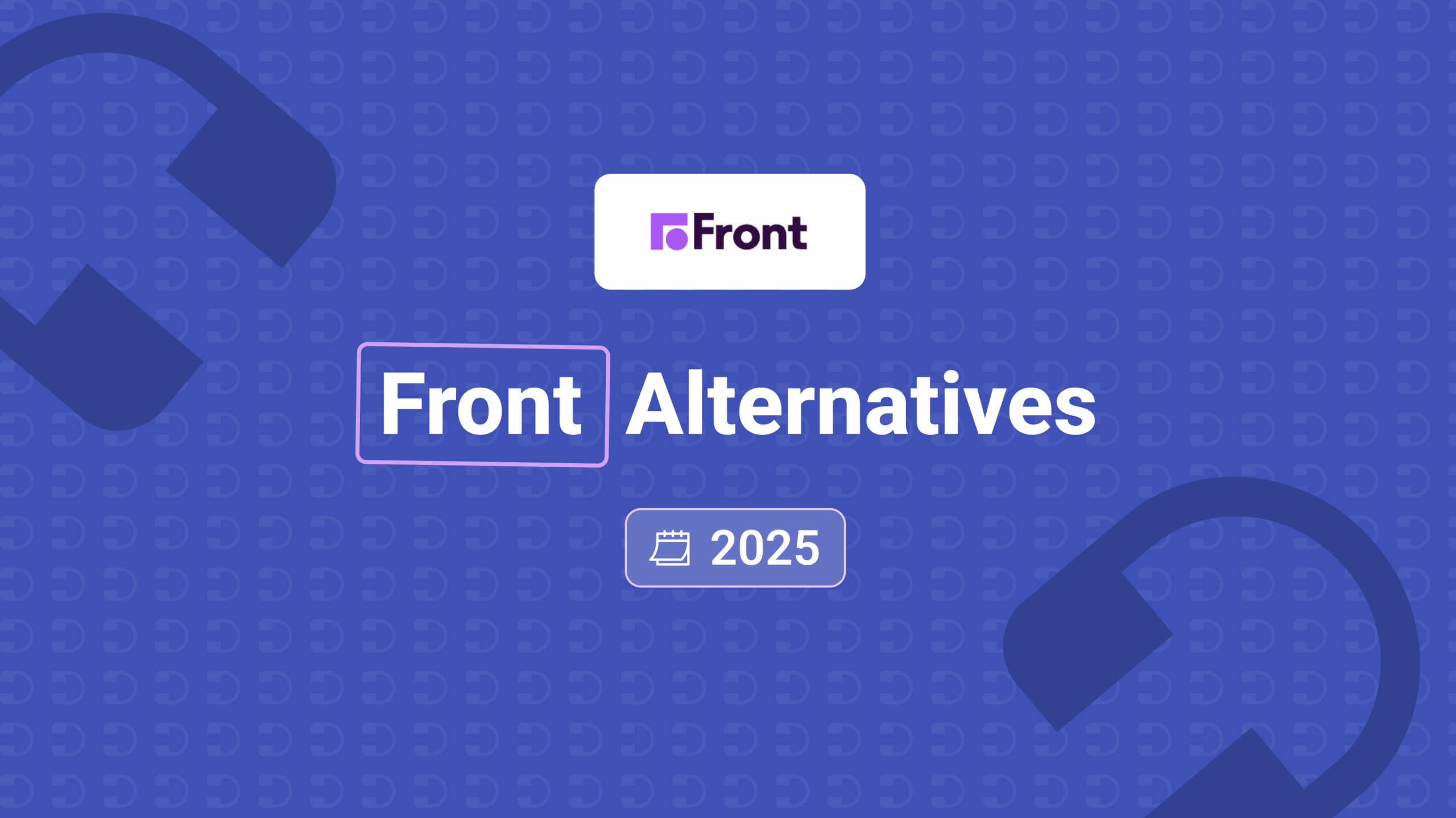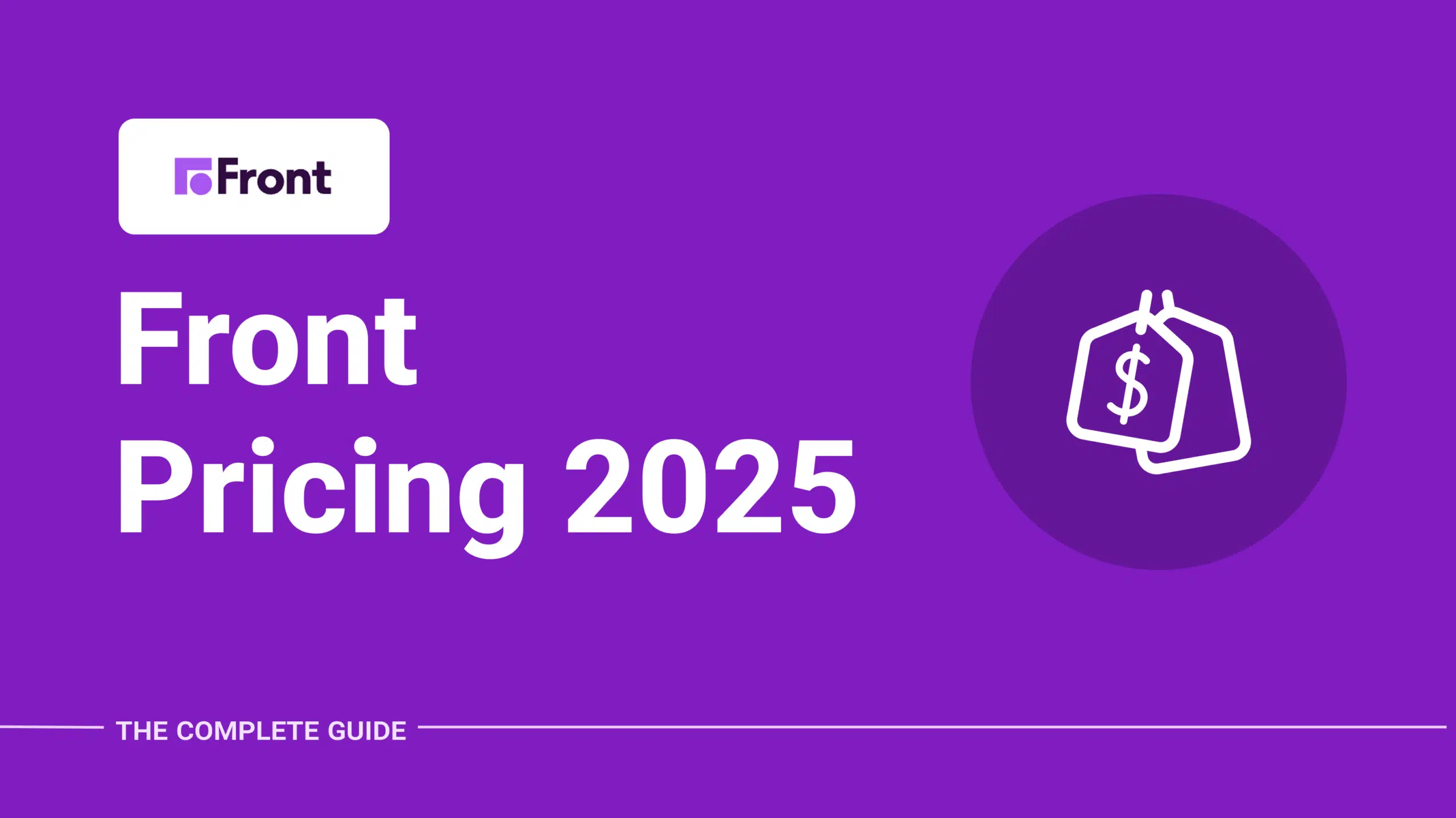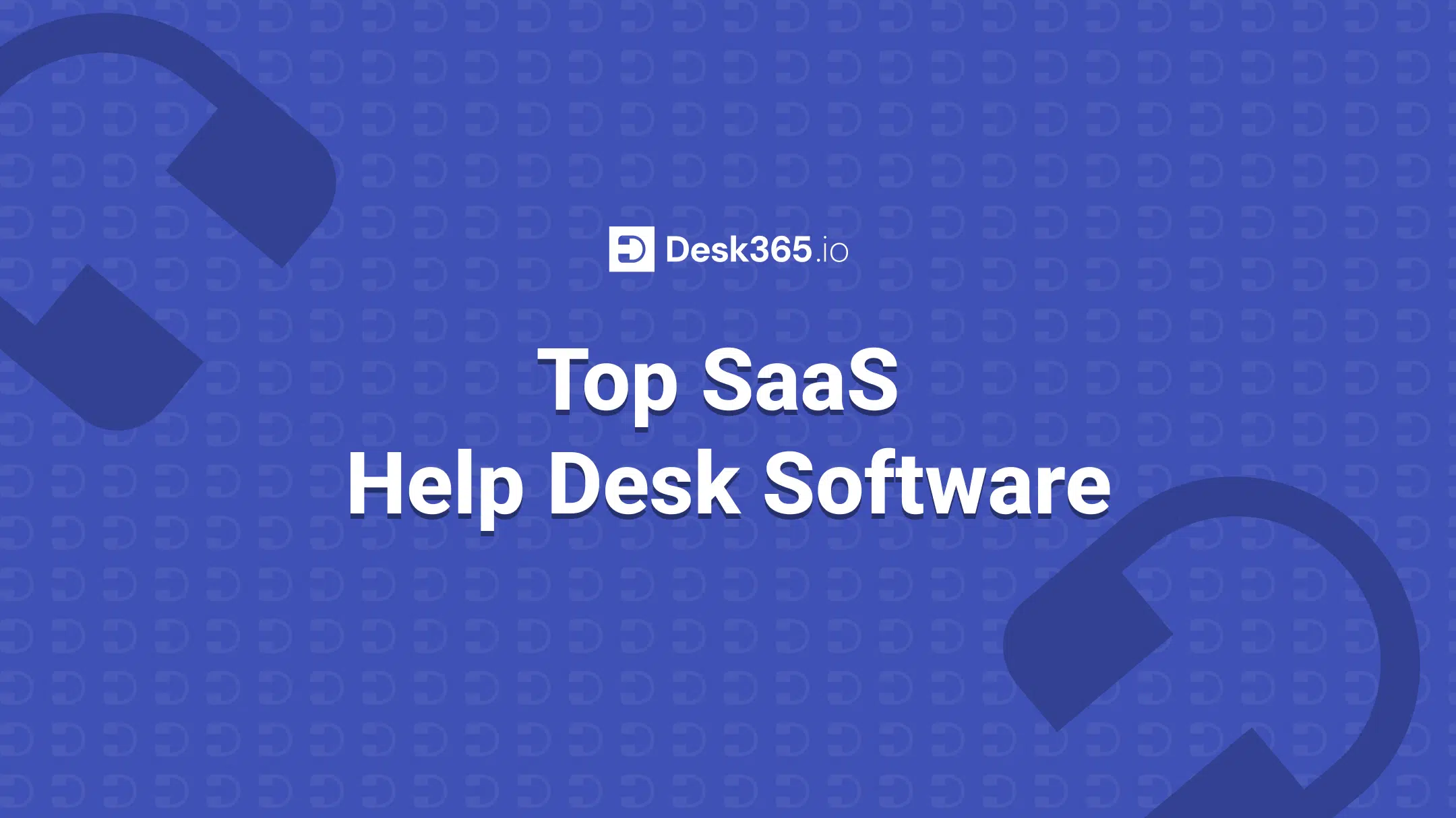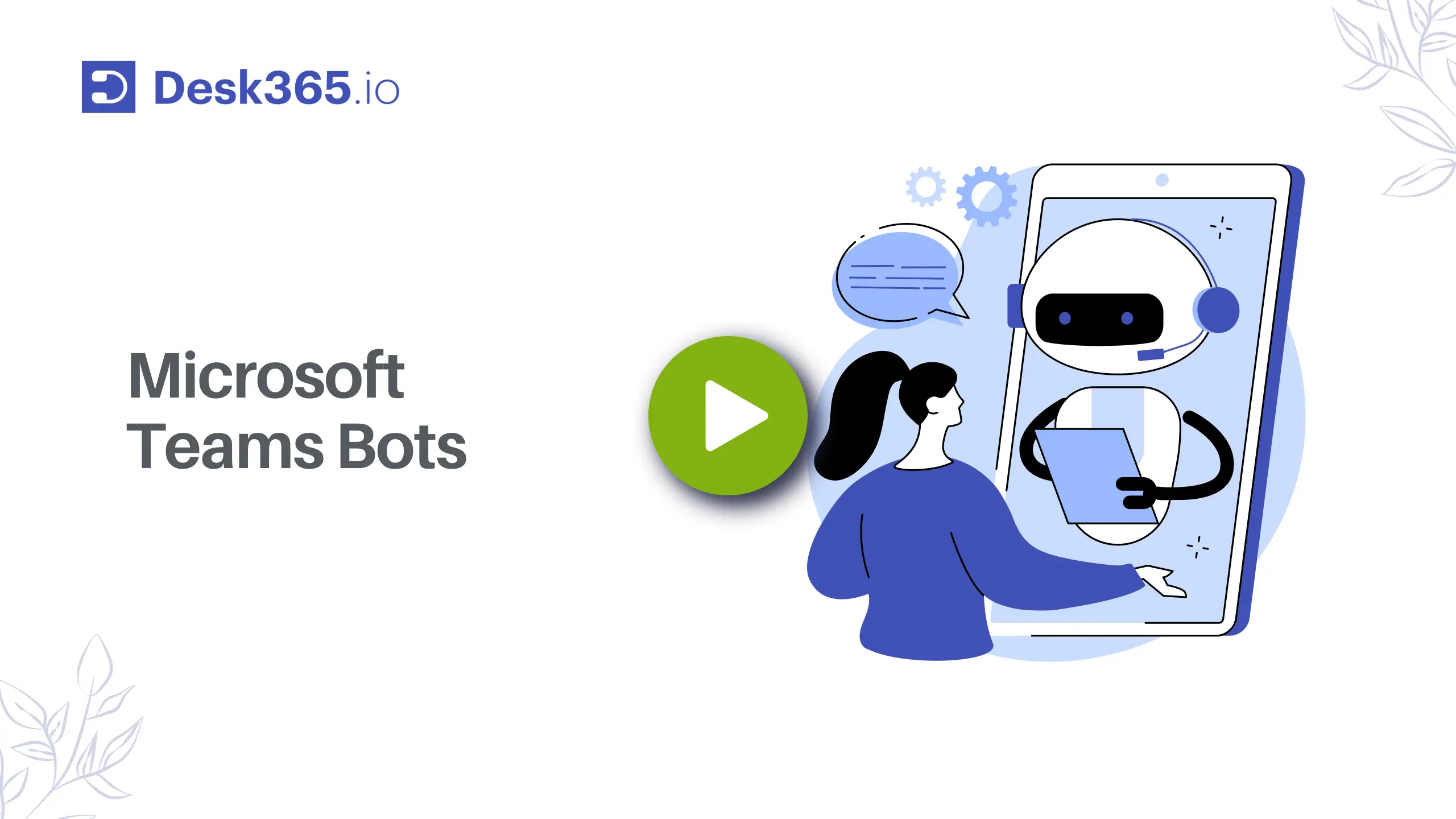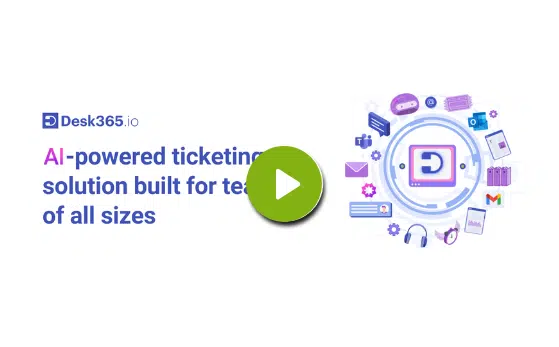If you’ve ever managed a shared inbox or customer support channel, you’ve probably heard of Front, the email collaboration tool that helps teams manage communication more efficiently. It’s a solid platform that brings structure to messy inboxes and makes teamwork easier.
However, as your business grows, you might start noticing a few drawbacks. Maybe the pricing feels too high, the setup is more complicated than expected, or you simply want something easier to use. That is when many teams start looking for Front alternatives.
The good news is that there are plenty of great tools available. Some focus on simplicity and affordability, while others offer deeper CRM integrations or better support for multiple channels like chat and social media.
In this post, we’ll explore some of the best alternatives to Front, highlight what makes each option stand out, and help you figure out which one fits your team’s needs best.
Common Front drawbacks reported by users
According to Capterra and other review platforms, while Front offers great collaboration tools, many users have pointed out recurring issues that affect their overall experience. The most common complaints include:
Performance issues with larger workloads
High pricing structure
Steep learning curve
Overwhelming setup for new users
Performance issues with larger workloads
Some users say Front becomes slower when handling a high volume of messages or complex workflows. As the number of users or integrations increases, performance may drop, making it harder to manage communications efficiently.

Review by a Capterra User
Can be slow with large volumes of messages or complex workflows. New users may need time to adapt to advanced features.
High pricing structure
Front’s pricing is one of the most common concerns among reviewers. Many teams feel the cost is high compared to other shared inbox tools, especially for smaller businesses that do not need advanced automation or analytics.

Review by a Capterra User
Pricing is quite steep, and depth of rules only goes so far–for example, SLA functionality is limited.
Steep learning curve
Although Front offers powerful features, new users often find it difficult to navigate. The platform’s extensive functionality can feel overwhelming at first and may require additional time and training to fully master.

Review by a Capterra User
The platform’s extensive features can be overwhelming initially, requiring time and training to fully utilize.
Complex and overwhelming design
Front’s interface is powerful, but not everyone finds it easy to use. Many users mention that the platform’s layout and features can feel cluttered, especially after recent updates.

10 best Front alternatives for your businesses in 2025
- Desk365
- Freshdesk
- Zoho Desk
- Missive
- Zendesk
- Help Scout
- Crisp
- DragApp
- Gmelius
- Tidio
#1 Front alternative: Desk365
Desk365 is an AI-powered helpdesk ticketing system that helps businesses streamline customer interactions and optimize ticket resolution processes. It offers powerful features such as AI-powered ticket responses, unified inbox, automation, omnichannel support, and in-depth reporting and analytics. Desk365 integrates well with other tools like Microsoft Teams and provides a customizable experience for agents and customers alike.
Key features
1. AI-powered ticket responses
Desk365 enhances agent efficiency by utilizing AI to generate quick, contextual replies. These AI-powered responses are based on historical ticket data and knowledge base articles, allowing agents to respond faster and with more accuracy. This significantly reduces the time spent on routine inquiries.
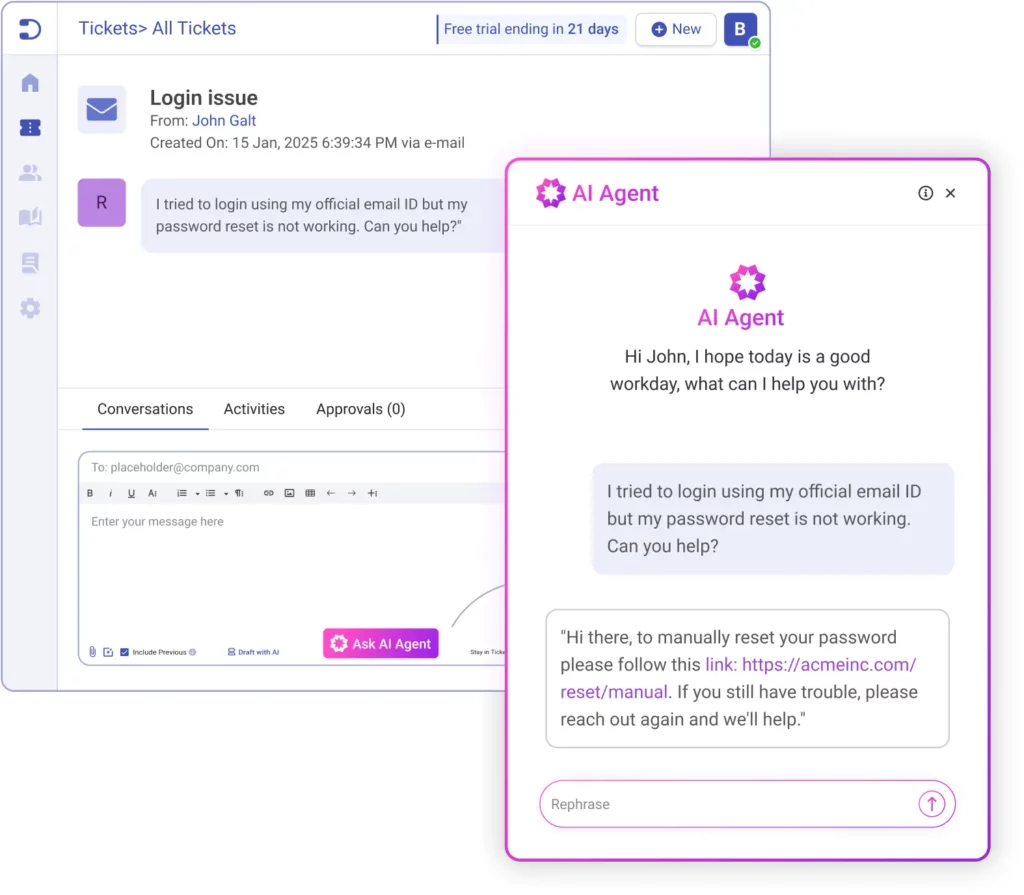
2. Service Level Agreements (SLAs)
Desk365 ensures timely resolution of tickets by monitoring SLAs. It provides periodic reminders to agents about upcoming due dates and alerts them when SLA infractions occur, helping teams stay on track and avoid delays.
3. Unified Inbox
Desk365 consolidates all customer support requests from various channels into a single, easy-to-use inbox. This feature allows agents to collaborate efficiently and manage requests without toggling between different communication platforms.
4. Automations
Desk365 offers a wide range of automation tools to improve productivity. For example, automation macros can be triggered when a ticket is created or updated, ensuring that routine tasks are handled automatically based on predefined conditions (such as ticket properties or customer events).
5. Real-time alerts and notifications
Instant notifications keep agents informed of updates to tickets. Whether it’s a new reply, a status change, or other activities, Desk365 ensures agents are aware of important developments in real-time, preventing them from missing critical updates.
6. Round Robin ticket assignment
To ensure a balanced workload, Desk365 includes a round robin ticket assignment feature. This automatically distributes tickets to agents in a balanced way, improving response times and preventing any one agent from becoming overwhelmed.
7. Knowledge base
Desk365 makes it easy to create and share knowledge base articles with your team and customers. The knowledge base can serve as a training tool for agents, and selected solution articles can be made public on the customer support portal, allowing customers to find answers on their own.
8. Custom ticket views and reports
Desk365 offers customizable ticket views and detailed analytics that allow you to monitor your team’s performance. You can track metrics like ticket resolution time, agent performance, and customer satisfaction, helping you to make data-driven decisions to improve your support process.
9. Omnichannel support
Desk365 integrates with multiple channels, making it easy for customers to reach you through the medium they prefer. Channels include:
- Microsoft Teams: Customers can create tickets, check statuses, and respond to agents all within Teams.
- Email: Incoming emails are converted into tickets, and agents can respond directly from the platform.
- Web Widget: A customizable widget that can be embedded on your website for easy ticket creation.
- Web Form: A configurable iframe form that can also be added to your website for seamless ticket creation.
10. Customization options
Desk365 allows extensive customization to suit the specific needs of your business. You can tailor:
- Agent roles and permissions for different levels of access.
- Ticket forms with custom fields and workflows to align with your processes.
- Support portal appearance to match your branding.
- Email settings and secondary email configurations for different departments (e.g., sales, marketing).
11. Powerful analytics
Desk365 includes powerful reporting tools that provide actionable insights into your support operations:
- Custom reports: Tailor reports to analyze any specific data related to your team’s performance, ticket trends, or customer satisfaction.
- Agent performance reports: Evaluate individual agent metrics like response times and ticket resolution rates.
- Ticket trends report: Visualize trends across different ticket fields to identify recurring issues or bottlenecks.
2. Freshdesk
Freshdesk is a cloud-based helpdesk and customer support platform. It centralizes customer queries from multiple channels (email, chat, phone, and social media) into one system, automates workflows, enables self-service through knowledge bases and forums, and provides AI assistance to agents. It helps support teams work efficiently, respond faster, and scale easily.
Key features
- Ticketing
- Automation
- AI (Freddy Copilot, AI agent)
- Self-service (Knowledge Base, community)
- Reporting & analytics
- Multi-channel support (Email, Chat, Phone, Social)
- Collaboration tools
- Customization & integrations
- Security & access control
Pricing
- Growth – $15/agent/month
- Pro – $49/agent/month
- Pro + AI – $78/agent/month
- Enterprise – $79/agent/month
3. Zoho Desk
Zoho Desk is a full-featured cloud helpdesk that unifies customer requests from email, phone, chat, social, forms, etc., into a single interface. With AI (Zia), automation, and a customizable environment, it helps support teams manage workflows, boost productivity, and integrate with the broader Zoho ecosystem for CRM, analytics, and more.
Key features
- Ticketing & multi-channel support
- Automation & workflows
- AI assistance (Zia)
- Self-service (Help Center, FAQs)
- Reporting & dashboards
- Customization & integrations
- Role-based access & security
Pricing
- Free (up to 3 agents)
- Standard: ~$14/user/month (annual)
- Professional: ~$23/user/month (annual)
- Enterprise: ~$40/user/month (annual)
4. Missive
Missive is a collaborative messaging and email tool built for teams. It merges shared inboxes, internal chat, and task management. Teams can assign conversations, drop internal comments, automate processes, and bring in SMS or social messaging, all in a cohesive workspace.
Key features
- Shared inbox & messaging
- Internal comments / threads
- Automation & rule setting
- Integrations & API
- AI (for drafting, translation)
- Multi-channel support
Pricing
- Free plan (limited)
- Starter: ~$14/user/month (annual)
- Productive: ~$24/user/month (annual)
- Business: ~$36/user/month (annual)
5. Zendesk
Zendesk is a robust customer support platform built to scale. It centralizes support across channels (email, chat, phone, social) into a ticketing system, with automation, AI tools, self-service knowledge bases, and analytics. It emphasizes flexibility, extensibility, and integrating customer experience with business operations.
Key features
- Ticketing & omnichannel
- Automation & workflows
- AI agents & Copilot
- Help center / self-service
- Reporting & analytics
- Integrations & app marketplace
- Role & permission management
Pricing
- Starting ~$19/user/month
- Higher tiers add AI, more channels, enterprise features
6. Help Scout
Help Scout is a support tool centered around email and conversational communication. Its design emphasizes simplicity and human-centered interactions: shared inboxes, live chat (via Beacon), knowledge base (Docs), and team collaboration features. It’s tailored for businesses that prioritize personal, email-first support rather than heavy process-driven workflows.
Key features
- Shared inbox
- Email + live chat support
- Knowledge base/docs
- Reporting & analytics
- Team workflows & permissions
- Integrations & API
Pricing
- Free (limited contacts)
- Standard: $50/month
- Plus: $75/month
- Pro / Enterprise tiers for higher contact volumes
7. Crisp
Crisp is a messaging-oriented customer support platform focused on live chat, chatbots, and real-time communication. It lets you interact with users via website chat widgets, integrate bots to handle framing or simple queries, maintain a shared team inbox, and provide self-service through knowledge base or FAQs. It’s especially useful for engaging visitors and converting support in real time.
Key features
- Live chat / chat widget
- Ticketing / inbox
- Bots / automation
- Knowledge base
- Multi-channel messaging
- Team inbox & collaboration
Pricing
- Free plan (basic)
- Pro plan: ~$25/month (for small team seats)
- Unlimited / full-feature plans higher
8. DragApp
DragApp converts Gmail into a helpdesk / collaborative workspace. Instead of switching to a separate helpdesk tool, teams work inside Gmail but gain capabilities like shared inboxes, Kanban-style boards for emails, task assignments, comments, automation, and integration with other channels (e.g. WhatsApp). It keeps the familiar Gmail interface but layers support-team features on top.
Key features
- Shared inbox inside Gmail
- Boards / Kanban view
- Automation & rules
- AI assistants
- Multi-channel routing (email, WhatsApp)
- API & custom fields
Pricing
- Starter: ~$12/user/month (annual)
- Plus / Pro: ~$18–24/user/month (annual)
9. Gmelius
Gmelius enhances Gmail (and sometimes Outlook) by transforming it into a team collaboration and support environment. It adds shared inboxes, email sequences & automation, shared notes/comments, Kanban boards, integrations, and workflow tools—all within or tightly linked to the email environment. Teams can handle customer support, sales, and project workflows from within their inbox.
Key features
- Shared inboxes
- Email sequences & automation
- Shared notes & comments
- Kanban boards or pipeline workflows
- Integrations & APIs
- Reporting & analytics
Pricing
- Free tier (limited)
- Paid plans: typically ~$9–25/user/month (depending on features)
10.Tidio
Tidio is a conversational support platform combining live chat, chatbots, and multichannel messaging. It aims to help businesses talk with visitors and customers in real time across web chat, Messenger, Instagram, WhatsApp, and email. Its AI / automation features let you automate responses, manage conversations centrally, and reduce response times, especially in high-volume environments.
Key features
- Live chat widget
- Chatbots / automation
- Email & message aggregation
- AI responses & suggestion
- Knowledge base
- Integrations (e-commerce, CRM)
Pricing
- Free plan (basic)
- Paid plans from ~$24/month (workspace level)
- Higher tiers for advanced AI, more users
Which is the best alternative to Front?
If you had to pick one, Desk365 is a strong Front alternative.
Here’s why it stands out:
It’s an AI-powered ticketing and helpdesk platform that works well for teams of all sizes.
It supports a unified inbox, automation, knowledge base, customizable roles, custom fields, and full omnichannel support.
It integrates seamlessly with Microsoft Teams, allowing users to manage tickets directly within Teams.
It’s built to scale while staying flexible, intuitive, and simpler than most enterprise helpdesk systems.
By taking advantage of 21-day free trials, you can experience firsthand how Desk365 offers a more user-friendly and straightforward experience.

